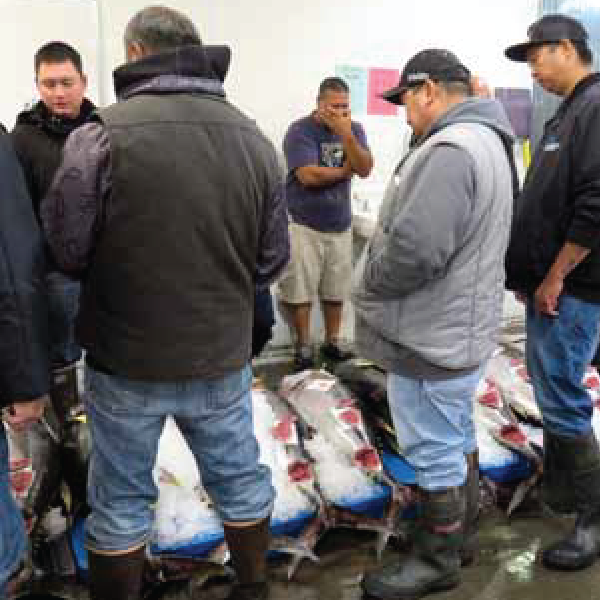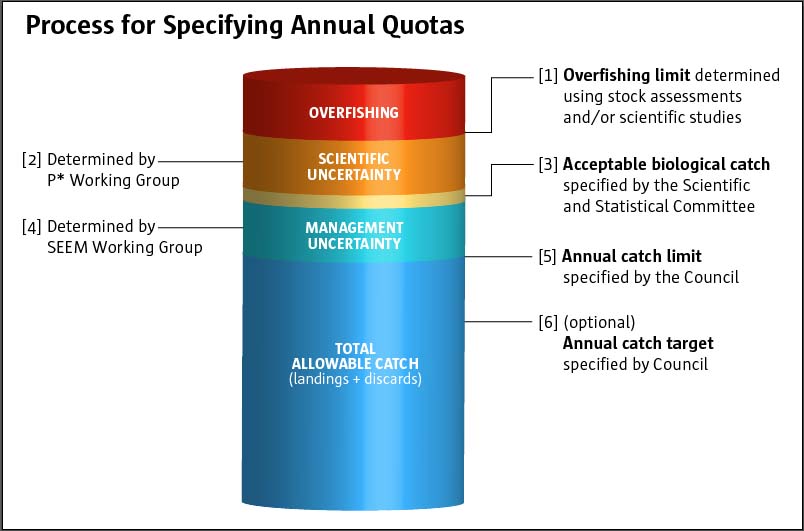Quotas + Annual Catch Limits
 In 2006, the reauthorized Magnuson-Stevens Fishery Conservation and Management Act (MSA) included additional requirements to prevent and end overfishing and rebuild overfished stocks. To comply with the additional statutory requirements, the Western Pacific Regional Fishery Management Council amended its fishery ecosystem plans to include a mechanism for specifying annual catch limits (ACL) for all fisheries at a level such that overfishing does not occur and to implement measures to ensure accountability (AM) for adhering to these limits. The reauthorized MSA further directed that this mechanism must be established unless otherwise provided for under an international agreement to which the United States participates. The United States has agreements with the Western and Central Pacific Fisheries Commission (WCPFC) and the Inter-American Tropical Tuna Commission (IATTC) among others.
In 2006, the reauthorized Magnuson-Stevens Fishery Conservation and Management Act (MSA) included additional requirements to prevent and end overfishing and rebuild overfished stocks. To comply with the additional statutory requirements, the Western Pacific Regional Fishery Management Council amended its fishery ecosystem plans to include a mechanism for specifying annual catch limits (ACL) for all fisheries at a level such that overfishing does not occur and to implement measures to ensure accountability (AM) for adhering to these limits. The reauthorized MSA further directed that this mechanism must be established unless otherwise provided for under an international agreement to which the United States participates. The United States has agreements with the Western and Central Pacific Fisheries Commission (WCPFC) and the Inter-American Tropical Tuna Commission (IATTC) among others.
The MSA requires the Council and the National Marine Fisheries Service (NMFS) to ensure long-term fishery sustainability by ending and preventing overfishing and by rebuilding overfished stocks. In developing the national advisory guidelines for complying with National Standard 1 (NS1), NMFS established an operational framework to explain the relationship among overfishing limit (OFL), acceptable biological catch (ABC), ACL and annual catch target (ACT) as they relate to maximum sustainable yield (MSY) and overfishing.
Maximum Sustainable Yield and Overfishing Limit
MSY is the maximum catch that can be harvested from a fishery on a continuing basis under prevailing conditions. If a stock or stock complex in a fishery is harvested on a continuing basis at MSY (corresponds to Fishing Mortality at MSY denoted by FMSY), its abundance will approach a long-term average biomass (corresponds to Biomass at MSY denoted by BMSY), at which it will fluctuate. MSY, FMSY and BMSY should be estimated for each stock based on the best scientific information available; however when such information is not available, these values should be estimated using proxies, to the extent possible.
Acceptable Biological Catch
Because MSY and OFL are estimates, there is an inherent level of uncertainty in the accuracy of these estimates due to scientific uncertainty in the information that is used in their calculation. Therefore, NS1 requires that an ABC limit be established at or below the OFL through the use of an ABC control rule to account for this uncertainty. Additionally, given the inherent uncertainty in the estimates in OFL, there is a probability (P) that the value set for ABC may exceed the true (but not precisely known) value of OFL, thus catch at ABC could actually result in overfishing. Therefore, when possible, ABC should be set such that P is less than some acceptable risk of overfishing (P*), as determined by the Council. According to NS1 guidelines, the probability that overfishing will occur cannot exceed 50 percent and should be a lower value. NS1 clarifies that it is the responsibility of the SSC to recommend the ABC to the Council.

